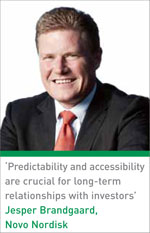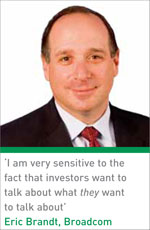What sort of CFO takes on IR responsibilities?
Mary Ann Arico is an experienced IRO. The head of investor relations at HealthSouth and winner of the best IR professional gong at the latest IR Magazine US Awards has been in the profession for more than a decade.
In that time, her biggest challenge has been – in her words – management that just doesn’t get it. And by ‘it’, she means IR. The management member in question, a CEO at a previous company, had little public company experience and failed to engage the Street.
Back in 2001, as a newcomer to IR, there was relatively little Arico could do to effect a change in the situation. In fact, she looks back at this time as a ‘maintenance job’, doing the best she could with an aloof leadership team in place. This experience is not uncommon, either. Cole Lannum, vice president of IR at Covidien and another award-winning IRO at this year’s US awards, bears similar battle scars from his time as IR head at Mallinckrodt. Management failed to keep him in the loop and the experience ultimately contributed to him leaving the company for a second stint on the buy side.
This experience is not uncommon, either. Cole Lannum, vice president of IR at Covidien and another award-winning IRO at this year’s US awards, bears similar battle scars from his time as IR head at Mallinckrodt. Management failed to keep him in the loop and the experience ultimately contributed to him leaving the company for a second stint on the buy side.
That disconnects like this can scupper the effectiveness of IR, not to mention leading IROs, comes as little surprise, given the importance investors place on access to management.
Almost two thirds (64 percent) of US investors view meeting with senior management as highly important, and that research finding, published in IR magazine’s latest US investor perception study, is indicative of the general trend in North America, Europe and Asia.
In Arico’s case, the communication issue was with the CEO. Today, though, it is more likely to be the CFO who has day-to-day executive responsibility for IR; on a global basis, two thirds (67 percent) of IR teams report to the CFO.
This figure increases to 72 percent in the US and 83 percent at the very largest US companies, according to the Global IR Practice Report, published by IR Insight, IR magazine’s research arm, at the end of last year.
HealthSouth is a recent example of the trend: when Arico first joined the healthcare provider in August 2008 she reported to the CEO; since then her reporting lines have switched to the CFO. Not that she has any complaints about her current management. She even plays golf with the chief executive and the COO, although the CFO is not a golfer.
Perfect partnerships
A few standout examples of CFO and IRO partnerships have emerged during the past year: Matthias Zachert (now CFO of Merck) and Oliver Stratmann at Lanxess, sixth in the Europe Top 100; Lora Ho and Elizabeth Sun at TSMC of Taiwan, second in the Asia Top 50; and Olivier Lim and Harold Woo at CapitaLand of Singapore, third in the Asia Top 50.
Each individual won an award for his/her individual IR efforts and his/her respective company finished among the regional top 10. A few other CFO winners – like Eric Brandt of Broadcom – take a firm lead on IR because of an enduring commitment to investor relations.
On the face of it, these best CFOs in the world of IR – 13 in all, identified by IR magazine’s global awards research over the past 12 months (see Best CFOs for IR, 2011-2012, below) – have little in common. They operate in different industries in different global locations; only two of the 13 sit on the board.
But they all share a few character traits that IROs could benefit from in their own CFOs.
Generous with time: Setting aside enough time for investor relations is the first hallmark of IR-attuned CFOs. Greg Hayes, CFO of United Technologies, reckons he spends 20 percent of his time on IR. Tom Weber, CFO of CML Healthcare, puts it between 15 percent and 20 percent.
John Steele, CFO of Werner Enterprises, estimates his time spent on IR even higher, at 25 percent, although he has no dedicated investor relations team to pick up the slack.  Outgoing: The perception of CFOs as office-bound bean counters and number crunchers should be consigned to history, says Zachert. A CFO, in his view, should be the conduit between the company and the capital markets.
Outgoing: The perception of CFOs as office-bound bean counters and number crunchers should be consigned to history, says Zachert. A CFO, in his view, should be the conduit between the company and the capital markets.
Jesper Brandgaard, CFO of Novo Nordisk, visits London and Copenhagen every quarter, and New York and Boston three out of every four quarters. In Hong Kong, Estella Ng, CFO of Country Garden, accompanies investors on regular site visits.
The same can be said of Olivier Lim at CapitaLand. ‘Looking at the plans of two different malls is very different from physically walking through them,’ he says.
Having said that, the consensus among the 13 finance chiefs is that investor conferences make for the most efficient use of their time. ‘When I go to conferences, we normally meet between 50 and 100 investors during the day – around 10 to 20 in one-on-ones and the rest in presentations and group meetings,’ Zachert says.
‘That’s the beauty of conferences.’ In the US, attending eight conferences a year is about average for a company; Hayes personally attended 18 conferences last year.
Interesting: Knowing the company numbers inside out is no longer enough. With portfolio managers and analysts covering more and more companies, you have to find ways to make your company and your industry interesting, says Steele.
That means knowing what’s going on at your competitors as well as understanding wider industry trends. Steele, for instance, personally goes through all the earnings releases and First Call notes of Werner’s competitors.
Eric Brandt takes a similar view. He knows investors ask him for his view of competitors with one eye on Broadcom and the other on investments in other stock. Far from being a cause of annoyance, Brandt sees providing that type of insight as one of the greatest benefits for investors meeting with management.  Good listener: Talking to investors also means listening to their concerns and perspectives. ‘In my view, you become a better leader and a better operator when you’ve got an active and healthy dialogue with shareholders and analysts,’ observes David Anderson, CFO of Honeywell.
Good listener: Talking to investors also means listening to their concerns and perspectives. ‘In my view, you become a better leader and a better operator when you’ve got an active and healthy dialogue with shareholders and analysts,’ observes David Anderson, CFO of Honeywell.
As a result, he says much of the communication from the US conglomerate has focused on responding to feedback from the investment community.
This requires more intimate one-on-one meetings with investors, rather than group meetings at conferences, so the company does a mixture of both.
The same personal attention is paid to the sell side at TD Bank. Post-earnings, Colleen Johnston phones each of the analysts who cover the stock, both to talk to them and to hear their concerns.
Team player: Finally, the leading CFOs also know their limits. ‘Even the most credible CFO can only do so much,’ accepts Lim.
Hence the CEO and business heads need to be put in front of investors, too. Brandt estimates that he can present a proportion of the overall business, roughly 50 percent, but it takes his CEO and those heading up the businesses to explain each of their units in greater depth.
Best CFOs for IR, 2011-2012USEric Brandt, Broadcom David Anderson, Honeywell Greg Hayes, United Technologies John Steele, Werner Enterprises Canada Tom Weber, CML Healthcare Thomas Peddie, Corus Entertainment Colleen Johnston, TD Bank Europe Matthias Zachert, Merck (formerly of Lanxess) Jesper Brandgaard, Novo Nordisk Asia Olivier Lim, CapitaLand Estella Ng, Country Garden Peter Kilgour, Swire Pacific Lora Ho, TSMC |










